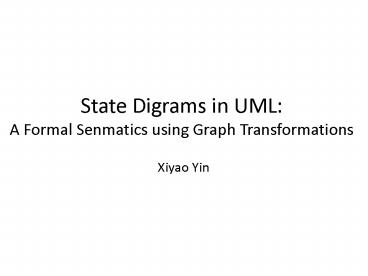State Digrams in UML: A Formal Senmatics using Graph Transformations - PowerPoint PPT Presentation
Title:
State Digrams in UML: A Formal Senmatics using Graph Transformations
Description:
A Formal Senmatics using Graph Transformations Xiyao Yin Overview Introduction of UML Features of UML State Diagrams Process of Deriving Graphs Graph Transformation ... – PowerPoint PPT presentation
Number of Views:176
Avg rating:3.0/5.0
Title: State Digrams in UML: A Formal Senmatics using Graph Transformations
1
State Digrams in UMLA Formal Senmatics using
Graph Transformations
- Xiyao Yin
2
Overview
- Introduction of UML
- Features of UML State Diagrams
- Process of Deriving Graphs
- Graph Transformation Systems
- Transitions to Nested States
- Conclusion
3
Introduction
- The Unified Modeling Language (UML) is a
general-purpose visual modeling language that is
designed to specify, visualize, construct and
document the artifacts of software systems. - Description of UML diagrams
- abstract syntax
- well-formedness rules for the abstract syntax
- semantics
4
UML State Diagrams
5
UML State Diagrams
6
Deriving Graphs
- The process of state expansion in nested state
diagrams is explained by graph transformations in
three steps - (1) adding boundary nodes introducing a precise
interface for the state to be expanded - (2) expanding the state
- (3) removing the boundary nodes
7
Deriving Graphs
8
Deriving Graphs
9
Graph Transformation Systems
- Definition Let C (CA, CN ) be a pair of color
alphabets. - A C-colored graph G is a six-tuple (GA, GN, s,
t, mA, mN ), consisting of - 1. sets GA and GN , called the set of arcs and
the set of nodes - 2. source and target mappings s GA ?GN t
GA?GN - 3. arcs and nodes coloring mappings mA GA?CA
mN GN?CN
10
Transitions to Nested States
11
Transitions to Nested States
12
Transitions to Nested States
13
Transitions to Nested States
14
Conclusion
- The general idea of the overall approach is to
rewrite UML diagrams to canonical graph
representation. We achieve a normal form for
nested UML state diagrams by means of graph
transformations. - The main advantage of the graph transformation
approach is the closeness between the
mathematical graph representation and the UML
diagram representation. - This approach is applicable to other forms of UML
diagrams as well.
15
Thank you!

